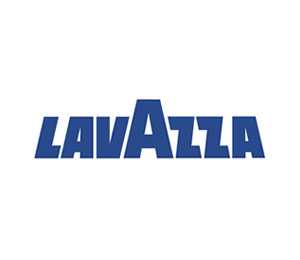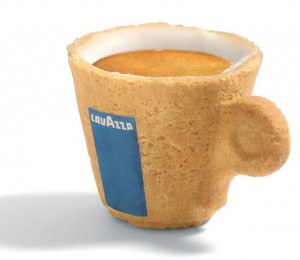An innovation by the baker Enrique Luis Sardi and the Italian coffee producer Lavazza has the potential to contribute largely to the establishment of edible packaging in the Italian coffee drinking culture.
The coffee packaging innovation is no advanced biotechnological invention, but rather a quite simple concept with fruitful results. Its outer layer consists of a special Italian biscuit, the Amarettini, which bestows the cup stability and insulation.
The inner layer of it is sugar glazing that prevents soaking through and gradually sweetens the espresso the longer it is in the cup. This is supposed to enable the optimal espresso experience.
By reducing waste and providing a powerful “snack experience”, the innovation is killing two birds with one stone. With the large number of coffee shops illustrated on the right at the example of Rome, one can imagine the enormous amount of packaging every day, just from plastic and paper coffee mugs.
That is, also the large amount of waste is obvious. Countless numbers, piles and tons of plastic and paper packaging from the coffee cup every day contribute to the pollution of the global environmental system and also to the waste of energy, as those empty cups cannot be reused and the manufacturing energy is completely wasted.
Using the edible packaging concept from Italy is a step to confine this daily source of waste and environmental pollution to some extent. The Lavazza cup offers an environmental-friendly solution, since (assuming every customer likes the taste of the cup) it will be eaten up completely, so that no waste is left over.
At the moment, producing one Lavazza Cup is more energy intensive than a standard plastic version. Though the difference is that the production energy put into it can be eaten, just like croissant, whereas all the production energy of a plastic cup is lost when it is put in the waste.
The invention is regarded to “revolutionize your morning” (Morano-Williams). As the cup is made out of a pastry, it could potentially replace the morning snack, hence perfectly suited to Italian breakfast behaviors.
While the project is only aimed at Italy so far, European and potentially global expansion is considered as an option by Lavazza. Even though Espresso will not replace the coffee and the “to-go” quality of this cup can be questioned, it is an approach to edible packaging adopted by a mass manufacturer.
Social communities, also outside of Italy, have promoted and supported its communication. It is interesting to see that such an innovation is actually very well observed by society and that there is room for further expansion in this field.
There seems to be a lifestyle factor associated with this product that could also be adopted and exploited by future inventions in this field.
In terms of sustainability, Lavazza can reduce the pollution of the ecosystem, but more importantly, re-induce energy from the value chain that was completely given up before.
Over the coming decades all resources, especially food, are regarded to become increasingly scarce due to an ever-rising world population.
Limiting those wastes of energy will be at stake and the role of one-way products will deteriorate. However the principle of re-usage cannot be applied to all products, like to-go coffee cups, as it is very inconvenient and unhygienic.
This product offers a solution to this tension area and enables coffee drinkers to adopt a zero energy waste attitude and the benefits from one-way products at the same time. Even though applicability in present conditions might seem limited, it could be very interesting to follow this trend in the medium and long term.
It offers a great solution to some of the most fundamental problems that humankind will face in the future with regards to sustainability and comfort.
By Julian Hilbert
References:
Adams, D. (n.d.). Cookie Cup: The Mouth-Watering Edible Coffee Cup. Retrieved October 28, 2013, from www.bitrebels.com/design/cookie-cup-for-drinking-coffee/
Morano-Williams, E. (2012, July 25). Lavazza Releases Edible Coffee Cup | Emilia Morano-Williams | The Daily Meal. Retrieved August 28, 2013, from www.thedailymeal.com/lavazza-releases-edible-cup-coffee



















